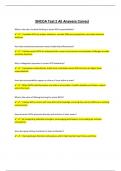SNCOA Test 2 All Answers Correct
What is the role of critical thinking in senior NCO responsibilities?
✔️✔️ It enables NCOs to analyze situations, consider different perspectives, and make informed
decisions.
How does situational awareness impact leadership effectiveness?
✔️✔️ It allows senior NCOs to understand the current environment and anticipate challenges to make
proactive decisions.
Why is delegation important in senior NCO leadership?
✔️✔️ It empowers subordinates, builds trust, and allows senior NCOs to focus on higher-level
responsibilities.
How does accountability support a culture of trust within a team?
✔️✔️ When NCOs hold themselves and others accountable, it builds reliability and fosters respect
across the team.
What is the value of lifelong learning for senior NCOs?
✔️✔️ It keeps NCOs current with new skills and knowledge, ensuring they remain effective in evolving
environments.
How do senior NCOs promote diversity and inclusion in their teams?
✔️✔️ By recognizing individual strengths, encouraging participation, and creating an inclusive
atmosphere.
How does goal setting contribute to team motivation?
✔️✔️ Clear goals give direction and purpose, which help maintain team focus and drive.
,Why is professional development essential for senior NCOs?
✔️✔️ It prepares them to handle greater responsibilities and adapt to leadership challenges.
How can senior NCOs foster a positive team culture?
✔️✔️ By establishing mutual respect, supporting open communication, and promoting shared values.
What is the importance of ethical decision-making for senior NCOs?
✔️✔️ It ensures choices align with core values, protecting the integrity of the organization.
How does empathy enhance leadership effectiveness?
✔️✔️ It allows NCOs to connect with team members, understand their needs, and provide support.
Why is it essential for senior NCOs to be role models for resilience?
✔️✔️ It inspires team members to overcome obstacles and persevere through challenges.
What role does constructive feedback play in team growth?
✔️✔️ It helps individuals improve their performance, encourages continuous development, and
strengthens team dynamics.
How does self-awareness contribute to a senior NCO’s leadership growth?
✔️✔️ It helps NCOs understand their strengths and areas for improvement, enhancing their impact.
Why is transparency important in leadership communication?
✔️✔️ It builds trust, reduces misunderstandings, and fosters open dialogue with team members.
Purpose as a profession ✔️✔️serve society by effectively delivering a necessary and useful service
Each profession establishes ✔️✔️a unique subculture that distinguishes practitioners from the society
they serve (and other professions) while supporting and enhancing society
,have unique standards of performance and codes of ethics to create and maintain their effectiveness
Professions also ✔️✔️develop particular vocabularies/terms, establish journals, and sometimes adopt
distinct forms of dress (lab coats, police uniforms, etc)
Military Professions differ in two ways: ✔️✔️consequences of failure in the POA for both individual
members of the Armed Forces and the Nation are more serious than those in any other profession
Military serves a collective client, the nation
Examples of responsibilities ✔️✔️include recovery of a community or country devastated by natural
disaster (operation unified response-Haiti), the defeat of enemy forces (operation Iraqi freedom) or the
security of the nation (operation noble eagle) which failure could result in catastrophe for the nation
Second difference for military profession ✔️✔️concerns individual members. We take our oaths of
office which includes understanding of 'unlimited liability' clause where its expected its members lay
down their lives for their friends, family, or freedoms. Risking their lives with personal sacrifices
American Proffession of Arms (American POA) ✔️✔️other nations with military considered peers.
where we differ: service orientation, distinct sub-culture, and body of theory/specialized knowledge
Service Orientaiton (A-POA) ✔️✔️essential for an occupation to be categorized as a profession. those
in it should not be in it soley for their own material benefit. Have some sense of duty towards the issues.
i.e. health care, education, counseling nobility of purpose within each of us and provides deep personal
meaning to all who serve-ties to founding document of the nation
Distinct Sub-Culture ✔️✔️the most obvious aspect of all professions
includes values, norms, symbols that are accepted by the profession i.e. insignias, emblems, distinctive
dress Clear and controlling symbols
Distinguish between officers and noncommissioned officers expected to exercise initiative to identify
and resolve unforeseen circumstances
, Body of Theory/Specialized Knowledge ✔️✔️more than technical training and skill to do a given job.
Professional competence is critical to a profession because the service provided by professions could
have beneficial or devastating effects on the population it serves
Prolonged education and experience
3 dimensions of POA ✔️✔️Physical, Intellectual and Moral
Physical Dimension ✔️✔️warfare is a physical 'business'. Joint force applies powerful measures to
destroy assets and resources essential to our adversaries' interests. Nature of these situations requires
considerable physical energy, stamina, skills, and training-all have impact on health of the force
-Air Force Fitness Program-promotes/benefits of active life-style help increase productivity, optimize
health, and decrease absenteeism while maintaining a higher level of readiness needed to meet this
dimension of the POA.
Intellectual Dimension ✔️✔️due to the expertise required to employ joint forces in military
operations. From Strategic-expertise is exercised with other instruments of national power (diplomatic,
informational, and economic).
-From Operational/tactical perspectives-mil professionals exercise their expertise against intelligent
adversaries actively seeking to defeat them in life-and-death situations.
Two Cultural aspects of POA (Intellectual Dimension) ✔️✔️Internal and External
-Internal: pertains to knowledge of military values-based culture (addresses Air Force Guiding
Values/Standards section)
-External: pertains to the need to adapt to varying environments with different cultural and political
values. must be culturally aware/sensitive
Moral Dimension ✔️✔️the authority to wield it carries a moral responsibility of the greatest
magnitude
-Law of Armed Conflict, UCMJ, and Code of Conduct give structure to its moral standards
-Included is civilian control of the military and are responsible to congress, President, supreme court
-Physical, intellectual and moral dimensions form the ✔️✔️foundation of OA and are the basis of
professional military education and leader development




